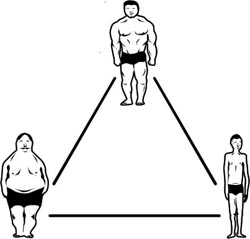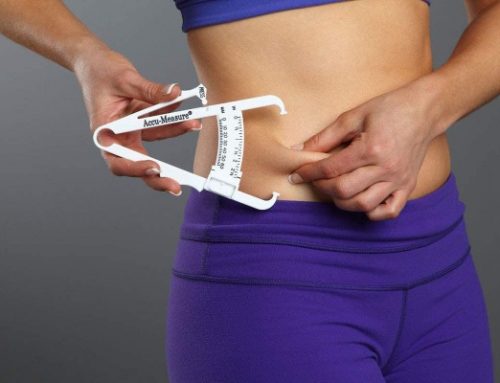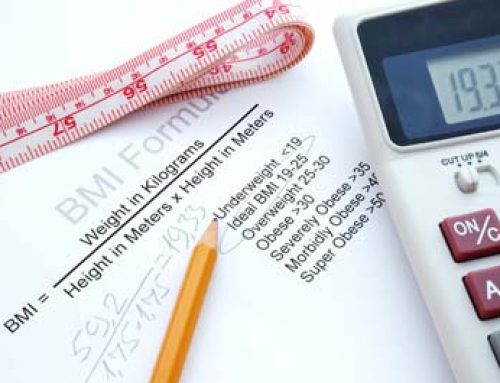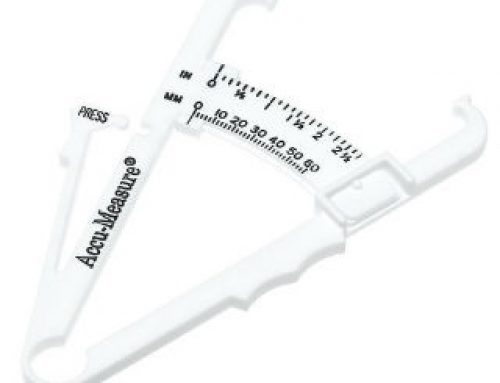Rating your body type using the classic system invented by William Sheldon is called “somatotyping.” Most people just use the term body type instead of somatotype, but whatever you call it, people have been intrigued by this concept for years…

Back in the 1980’s and 1990’s when I first started lifting, almost every book I read about bodybuilding had a section explaining the three major body types. Most of the authors and experts believed that knowing your body type was a useful tool for adjusting your training and nutrition.
Today, some fitness authorities claim that body typing is outdated and not helpful. They may be partly right, but I don’t think you should throw out the baby with the bathwater. If you approach body type analysis from a more modern point of view, it can be useful in many ways.
The Three Major Somatotypes:
According to Sheldon’s system, there are three major body types:
Endomorph – large frame, large joints, round, high body fat
Mesomorph – average frame, medium joints, muscular, lean
Ectomorph – small frame, small joints, skinny, very lean
Using the numerical scale, you could get even more specific by assigning a score of 1 to 7 for how strongly you fit into each category. Pure body types (a 7 on the Sheldon scale), are rare, but do exist. A pure ectomorph – someone who is tall, extremely skinny (not much muscle), and doesn’t have an ounce of fat – might rate endomorph: 1, mesomorph: 1, ectomorph: 7 (1-1-7).
It’s common to have a mix of body types, but usually one or two are dominant, such as endo-mesomorph or ecto-mesomorph. For example, you could have a 7-3-2 (endo-meso-ecto) body type, which is mostly endomorph and a bit meso and ecto, or you could be a 1-5-5 (endo-meso-ecto), which is a strong mix of mesomorph and ectomorph. You can’t have a high endomorph and ectomorph score at the same time, because they are opposite ends of the spectrum.
Scoring your body type using the Sheldon system can only be done through visual observation, so without photographs, or at least an extremely detailed verbal description that gives a good mental picture, we can’t identify your category. However, usually your own self-assessment is correct. For example, if you think you have an element of mesomorph, because you had natural muscularity before you even started lifting weights, then you probably do.
This is a fascinating subject with an interesting history, but spending a lot of time trying to figure out your exact 7-point score isn’t necessary except out of pure curiosity. Your body type is not the most important thing to know for customizing your training and nutrition plan. What can be helpful is understanding your dominant body type (or primary two-type mix).
It’s also helpful if you look at this from the more modern and scientific point of view. The somatotype system was developed in the 1930’s, before the bodybuilding and fitness field had developed yet, and the original body typing system had limitations and flaws. That’s why it’s a fair question to ask, “Does knowing your body type even matter for achieving your fitness goals?”
Rating your somatotype with the old Sheldon system is only a tool to classify how your body looks now. Saying you look like an endomorph, mesomorph or ectomorph doesn’t distinguish between your inherent tendencies which are dictated by genetics (what’s hard-wired into your DNA, known in modern terms as genotype), and the way your body changes due to training and nutrition (the way your genes interact with environment and behavior, known today as phenotype).
Saying you’re an endomorph is kind of like saying your eye color is blue, your hair color is blonde or your height is six feet tall. This is describing physical characteristics, which are obvious. The more relevant questions are, how easily changeable is your present appearance, and how helpful is knowing your body type for adjusting your nutrition and training plans?
Modern Body Typing For the 21st Century
By giving names to the basic body structures, Sheldon created this field and laid all the groundwork. However, newer approaches to body typing theory, such as the Heath-Carter method and the way I explain it in the Burn The Fat, Feed The Muscle (BFFM) book, are more useful.
Modern body typing theory is an improvement on the original somatotyping system for a few important reasons:
1. The modern body type theory acknowledges that your body appearance can change with exercise, diet and aging.
Sheldon created his system by examining bodies at one fixed moment in time, and he believed that for the most part, your body type doesn’t change. However, it’s plain to see that some aspects of your appearance like body fat and muscle mass certainly can change over time, while others like your muscle insertions and bone diameters, are more or less fixed due to genetics.
Because the former can change with the right training and nutrition, you can start out looking like an unfit, overfat endomorph and after months of applied effort, end up looking like a muscular and fit mesomorph. When that happens, it begs a new question: If you achieve this type of body transformation, then which body type are you – an endomorph or mesomorph? The old system couldn’t address this.
A better body typing system would make the distinction between body composition and your inherent or “natural” body type. You can’t change your natural body type, which includes various genetic predispositions, but you can change your body composition dramatically if you make a concerted effort.
People who do nothing in the way of nutrition or exercise will in fact, gravitate toward a body composition settling point, and that is their natural body type. In our modern food-centric and sedentary society, the consequences of doing nothing are even worse than ever for those with less than Olympian genetics.
2. The modern body type theory may add metabolic characteristics to the body typing rating.
Some practitioners of modern body typing may also consider internal physiology, not just external appearance. If you have certain metabolic predispositions, knowing them may help predict things like how well your body handles specific foods or entire food groups like carbohydrates. (Generally, the endomorph tends to be more carb intolerant and requires more diligence with nutrition, sometimes leaning toward a lower-carb approach, but certainly a very calorie-conscious diet).
Getting this kind of information requires more than photos or visual assessment – it may require (blood) tests from a doctor or answering a battery of health and nutrition questions. Many of these body tendencies, especially food interactions, simply emerge through personal trial and error as well.
3. The modern body type theory identifies tendencies or dispositions – both genetic and behavioral.
You have basic structural and metabolic body characteristics that don’t change, but you’re not stuck looking the same for the rest of your life. You can change your body’s appearance because you can change your body composition. You have to remember though, that body composition can change for better or worse, depending on your lifestyle choices. Doing nothing is still a choice, one that leads to deterioration.
In addition to entropy being the automatic course of nature, you have natural tendencies, both biological and behavioral, which influence the direction you lean if you don’t make a conscious effort to change. If you’re making no effort to improve your body composition and you naturally lean toward gaining fat and getting heavier, you have endomorph tendencies. If you lose weight and muscle size easily and lean toward being skinny (no excess body fat problems), you lean toward the ectomorph tendencies.
Likewise, your natural tendencies influence how easily you improve when you do make the effort to change. It’s well-accepted in the exercise science community today that a group of people can have totally different response to the same training program. This is especially true for building muscle.
Studies have discovered genes that influence obesity, yet genetics dictate how much muscle mass you can build to an even greater degree. In other words, overweight people are more likely to be made than born (it’s more influenced by behavior and environment than genetics), and elite bodybuilders are more likely to be born than made (whether you can build extreme muscle mass is more influenced by genetics than behavior and environment).
Which Is More Important, Genetics Or Behavior?
What most people don’t realize when asking, “What is my body type?” is that they are basically asking the same supreme question millions of people have pondered in all areas of endeavor in life: Is your degree of success dependent on genetics (talent) or behavior (work)? In the context of fitness, the natural body type is the genetics and the training and nutrition is the work. If they both matter, which is more important?
Famous journalists and authors have tried to tackle this question in books, articles and discussions on sports and fitness, as well as in music, art and so on. The debates will no doubt continue, but the consensus is that of course genetics matter, especially in certain areas of athletic endeavor which require specific physical characteristics (which you may or may not have inherited).
What matters more to success is hard work over a long period of time (which positive psychologists today are calling grit). What also matters more is having a growth mindset – the belief that your growth is not fixed due to genetics, but that you can change and continue to improve for life, if you keep working hard. Why is this so important? Because your beliefs affect your behaviors, including how hard you work. There’s no way of knowing your real potential unless you consistently work for a long time.
In the endeavors of bodybuilding, fat loss and fitness, there is danger in thinking about body types as completely fixed or genetics as the ultimate arbiter of what kind of physique you can develop. That is forgetting the difference between body composition, which everyone can change with work, and natural genetic body type which is mostly unchangeable.
The biggest problem is that too many people analyze their body type and then let the label limit them. They do a Sheldon body type assessment and say, “Oh well, I’m an endomorph, which means I have bad genetics, so what’s the use, I’ll never get lean. That’s the attitude that makes people not even want to start, let alone work hard at it for a long time, even though it’s based on a false and self-limiting belief.
My natural body type is endo-mesomorph. With my body type, I’m able to gain muscle fairly well when I apply myself consistently to hard training (mesomorph), but I also discovered that my natural tendency if I stop working at it is to gain fat very easily and the fat comes off only with high activity level and very strict diet (endomorph). I am definitely not naturally lean. I find that I respond well to lifting, but my muscle size shrinks quickly when I don’t train very consistently. So my muscle building genetics aren’t bad, but they aren’t elite either. Even if I wanted to and if I had devoted my life to it, I could never look like Mr. Olympia Phil Heath.
Nevertheless, I went on to be successful in bodybuilding and fitness. No, I never turned pro, but I was able to build my physique to the point of competing and winning state and regional contests and even make the top two in national drug-tested competitions. More important, I was happy with how I looked. I was never trying to look like Mr Olympia. I was trying to improve, and I journeyed a long way from where I started.
If I would have compared myself to a pure mesomorph with perfect muscle bellies and bone structure, who got lean easily without much cardio, and tried to follow their nutrition and training programs, and their level of compliance, I would have become frustrated. I would have wondered why I didn’t look the same with the same level of effort in the same time. Instead, I adjusted my approach based on what I learned about my body type and did what it took for me for as long as it took for me.
Changeable Versus Unchangeable Physical Characteristics
Using a modern approach to body typing (and simply paying attention to your results), it’s not hard to figure out your natural type and use that information to enhance your fitness journey. Along the way, you must accept what you don’t have control over, and take massive action to change what you do have control over.
You can’t increase the width of your clavicle bones to make your shoulders look broader, but you can do exercises for your deltoids that will put on muscle and make you look wider. You can’t decrease the width of your hip bones, but you can burn off body fat and shrink your waist with the right diet. You can’t change a tall, lanky, small-jointed bone structure into a shorter, stockier one, but you can pack muscle on every body part with the right weight training program and nutrition.
If your waist gets smaller, your shoulders get wider, or you fill out a skinny frame from nutrition, training and lifestyle change, you end up looking like a different person. Did your body type change? Well, yes you went from looking like a fatter endomorph or skinny ectomorph to looking like an athletic mesomorph. But no, your inherent body type – your bone structure, muscle insertions and so on – did not change. What changed was body composition, and that’s how you can transform your appearance regardless of your natural body type.
If you look around the fitness community, you can find countless examples of ectomorphs who were skinny and became champion bodybuilders or endomorphs who were obese and became lean. On the other hand, you can find athletes who got fat and mesomorphs who got lazy and lost most of their muscle. Remember, body composition is changeable in both directions so we always must be on guard.
You can always change your body composition. That’s why there’s a flaw in the old ideas about body type being fixed or genetics determining your results entirely. If you put too much stock into body type, it’s tempting to think that the various body types are “good” or “bad,” and will benefit you or limit you. Your goal is to take what you have and make the most of it. Improve as much as you can. Work hard and see where it takes you.
How far can you go? You’ll never know unless you try. Optimism is a virtue and it’s better to set goals too high than too low, but you have to be realistic as well, especially with goal time frames. One way understanding body type is useful is that it helps you set realistic goals. This includes goals for the speed of making changes and for your ultimate long term ideal physique.
There’s no guarantee you will look exactly like the fitness model on the cover of Men’s Health or Shape magazine with any amount of work because you might not have the same body structure. Not all of us have the genetics to reach the top 1% in any sport.
Bodybuilding in particular, requires certain genetic traits such as the muscle belly length, number of muscle fibers, fiber type, and muscle insertion points. You can’t change those. Fat loss on the other hand, is less influenced by genetic factors than bone structure and muscle architecture. There are genes that affect obesity risk, but body fat levels are highly changeable.
The good news is, all of us have the potential to improve far beyond where we are now because the way your body looks now is a result of genetics (natural body type), combined with environment and behavior. Both matter, but you can control and change your environment to a great degree and you are completely in control of your behavior, so there’s no sense in losing sleep over whether you have the “right” body type.
Natural Body Type As A Tendency
Given these facts about body type versus body composition and genetics versus work, we realize that you can take pictures and rate your body type based on how you look now, but alone that’s not so helpful. It’s more revealing to see a set of before and after photos that show your trained and untrained state. Knowing how you look without training or dieting, how you respond to training, and what happens if you were trained, but then stop, gives more valuable clues about your natural body type. This information reveals your natural tendencies.
For example, if you had some degree of natural muscularity before you even started, your muscles are very responsive to training, and you don’t lose muscle quickly or completely when you stop training, you probably have a high proportion of mesomorph.
If you’ve carried excessive fat as long as you can remember, your body responds to training and diet, but slowly, and your tendency when you “slack off” is to lose your progress and gain body fat quickly, then your dominant body type is probably endomorph.
Likewise, a guy who has always been a “bean pole” – tall, skinny and lean, who responds to training and puts on muscle slowly, but gets skinny again quickly if he stops training, is a natural ectomorph.
“Use it or lose it” applies to everyone, no matter what type of genetics you have – it just happens to some faster than others. That’s why you can’t ever stop your training and nutrition disciplines, except for short (normal) recovery breaks. It you stop, your body composition will gravitate back toward a natural settling point. If you want to keep the progress you’ve made, health and fitness must be a lifelong commitment.
With persistence, many people have become successful, regardless of their body type. It’s not uncommon for a natural endomorph to sculpt such an amazing physique that people look at them and say they must be mesomorphs. But appearance can be deceiving. The truth is, it took incredibly hard work over a long period of time to get these results, yet observers don’t appreciate the effort that went into achieving that kind of shape – they might think they’re simply gifted. There’s a humorous, but true saying in bodybuilding and fitness, “The harder I work, the better my genetics appear.”
One of the reasons these natural endomorphs are successful in maintaining their lean, muscular bodies is because they understand their inherent body type and behavior tendencies. They know if they slacked off even a little bit, they might very quickly gain the body fat right back. As a result, endomorphs who get in top shape usually have developed great lifestyle habits, the discipline of champions, a terrific work ethic and eternal vigilance against slipping back.
In that sense, you could say having natural endomorph tendencies was an advantage. It’s axiomatic that nothing is more common than wasted talent. The most gifted don’t always become the best; they often coast on their genetics and are not the hardest working.
Why Behavior Is A Part Of Your Body Type
If we are interested in using body typing the modern way, it’s important to consider that our natural body type, where we start and tend to settle back to if we make no effort to change, is not only due to biology, but also to our behavioral tendencies.
The relaxed endomorph has a tendency to slow down and move less. The high strung ectomorph has a tendency to speed up, and move more. Stop and think about that for a minute: to a large degree, being an ectomorph has a lot to do with having a naturally high level of activity or NEAT. An endomorph has a naturally low level of activity. That’s the calories out side.
On the calories in side, an ectomorph, if they’re not simply burning up everything they eat without even thinking about it, may have the tendency for a lower appetite and eating less. An endomorph might have behavior tendencies to eat more, often until they are full, without even thinking about it. These types of behavior tendencies may be genetic or under the level of conscious awareness, and modern body typing theory proposes that these behavioral tendencies are a part of your natural body type.
The good news is, even if your naturally-inclined eating and activity behaviors are genetically influenced, your behavior is something you can always change, if you become aware of it and make the effort.
The Big Question: Does Your Body Type Even Matter In Bodybuilding, Fitness And Weight Loss?
The newer body typing approach is useful in many ways, because knowing your natural body type and tendencies helps you customize your nutrition and training plan more specifically for you.
For example, endomorphs fare better with more cardio, ectomorphs with less. Ectomorphs and mesomorphs may do better with more carbs, endomorphs with less. Endomorphs need a high level of activity to maintain fat they’ve lost, while ectomorphs need a low level of activity to maintain the muscle they’ve gained. When you know your body type, you can make these and other simple adjustments to your program that can help you achieve better results.
The biggest misunderstanding the average person has about this subject is that you should identify your type and then follow a training and nutrition program specifically for that type. That’s not how it works. In fact, that idea borders on pseudo-science, which is why the old body typing system attracted critics in the first place.
The fundamentals of good nutrition and training are the same for everyone. There is no ectomorph diet or endomorph workout. However, knowing you’re an ectomorph or endomorph does help you make small customized adjustments to your program to make it suit your body and your tendencies better. You can also use this knowledge about body type to set goals more intelligently. In addition, understanding the truth about genetics versus work and environment can help you develop a better attitude toward your body and your endeavors to get more fit.
Bottom line: The modern approach to body typing can be very helpful. Just be sure to acknowledge that your tendencies are both genetic and behavioral so there are some things you can change and some things you can’t. Then go to work on changing the things you can, and use the knowledge you have about your unique body type to fine-tune your plan.

Tom Venuto is a lifetime natural (steroid-free) bodybuilder, fitness writer and author of Burn The Fat, Feed The Muscle: Fat Burning Secrets of Bodybuilders and Fitness Models and the national bestseller, The Body Fat Solution, which was an Oprah Magazine and Men’s Fitness Magazine pick. Tom has appeared in The New York Times, Wall Street Journal, Huffington Post, Oprah Magazine, Muscle and Fitness Magazine, Ironman Magazine and Men’s Fitness Magazine, as well as on dozens of radio shows including Sirius Satellite Radio, ESPN-1250 and WCBS. Tom is also the founder and CEO of Burn The Fat Inner Circle – a fitness support community for inspiration and transformation
Related Articles:
Once an Endomorph, Always An Endomorph? (Can Your Body Type Change?)
The New Body Typing: How Do You Know If You’re Carb Tolerant or Carb Intolerant? (Members-Only Area)
Can Metabolic Typing Help You Find The Perfect Diet For Your Body Type? (Members-Only Area)






I started working out when I was 10 and got serious about it at 16, so it’s a little difficult to know for sure, but I think I was an ectomorph/mesomorph. I spent 33 years, from the time I was 10, trying to gain and maintain my weight. Fianally at 43, I was able to gain weight, but then it changed to, “Uh Oh, I’ve gained too much weight.” At first, I could still lose weight with a little effort, but now, at 65, I struggle with excess weight and wonder if my natural ectomorph body made a change to endomorph. Granted, I am not as active as I once was because I have worn out many of my joints, but I am still able to lift fairly heavy, so my metabolism shouldn’t have slowed down excessively. I haven’t been able to find any information supporting it, but have you ever heard of body types changing?
Our bodies can definitely change with aging, inside and out, as point #1 in the new body typing mentions in the article, though your same genetics will still be there. Rather than inherent body type, the biggest changes though, are in body composition. If you dont train (resistance training specifically), after you get older, sarcopenia (the loss of muscle) accelerates. Resistance training is the #1 key slowing or even stopping it. We can’t control some of the effects of aging, but with the right training, you can stay healthy and look fantastic, even at 65, and even look the best you have in your entire life. There were just two stories on the news recently about 80 year old competitive bodybuilders, both male and female. You may have to modify your training to be easier on your joints (it CAN be done), and you may not maintain the physical body composition peak of your youth, but rest assured, you can still maintain a muscular and lean body at any age.
Thanks for the quick response, Tom. I have modified my workouts to mostly static training, but I hoist some pretty respectable weights and still make progress(although slowly)by either holding the weight for longer periods or increasing the weight on the bar. My body is definately muscular, but no longer lean.
I think my biggest obstacle is overcoming five decades of not only eating anything I wanted, but eating extra in trying to gain weight. You would think that after 40 years in the health and fitness business, I would have more self control, but that doesn’t seem to be the case. I don’t eat junk because we don’t have it in the house, but I have discovered that I can overeat healthy food too.
Glad you found it helpful Charlyne. Thanks for reading!
Hi Tom,
As always the best fitness read on the web. Nothing but the honest truth.
I must say that I share the “With my body type, I’m able to gain muscle fairly well when I apply myself consistently to hard training (mesomorph), but I also discovered that my natural tendency if I stop working at it is to gain fat very easily and the fat comes off only with high activity level and very strict diet (endomorph).”.
Boy can I gain weight easily but I’ve found over the years that diet has a huge water retention effect on me. I once gained 7 kg in a week! and lost almost the same the week after. Being lazy for a week or two and I loose a lot of strength, but a few sessions and it comes right back. I have just accepted that my body requires constant discipline and work to be the best it can be.
Looking at my children there is definitely truth to the body type paradigm. My eldest is tall, lean and flexible like a gazelle, she also has the biggest appetite but does not gain anything. My boy is so lean and tall with the most varying appetite choices with some days just granny smith apples and other days cravings for cakes and bread but weight is as stable as can be. My youngest is more muscular and probably the most intriguing bodybuilder type build but boy is she a carby! She will devour anything bread related and will probably suffer the most in the world out there.
I have some work to do to teach her the best dietary wisdom so that she does not fall into my life traps.
Nutrition is so important and we’ve seen it with the kids that visit us on the farm. Where they are so overweight, no energy and picky about food choices, it is so unbelievable and parents are blind to the effects of nutrition. They always have the excuse that we are lucky because we have better genes. Then I show them the photos of me at 45% body fat compared to now. They are amazed but yet do not change anything.
I can only hope that I give my children the right tools, wisdom and guidance in life to maintain a healthy lifestyle and body into the future.
The article is much appreciated Tom.
Glad you found it helpful Charlyne. Thanks for reading!
working out is a great way to lose weight and rip that belly fat that is in hard to reach places. Keep up the good work and continue to inspire.